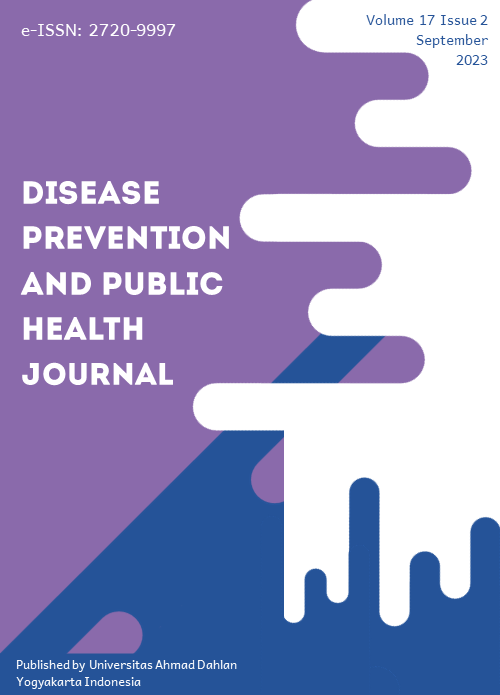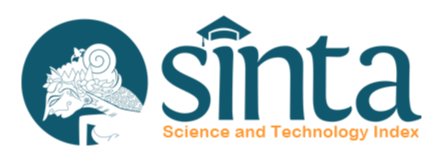Effects of High-Intensity Interval Training on Body Weight in Obese Adults
DOI:
https://doi.org/10.12928/dpphj.v17i2.8469Keywords:
HIIT, Obesity, Adult, Interval TrainingAbstract
Background: Obesity has become an epidemic and is a major threat to health. There are many ways to overcome obesity, one of which is exercise, but there are still reasons such as not having time to exercise. The purpose of this study is to discuss and describe the effects of High-Intensity Interval Training on weight loss in obese adults. Method: The method used in this study was a literature review using PRISMA to determine the number of articles used, the PEDro scale to assess each article, and check the quartiles of articles through schimago, then The articles were explained the population, intervention, comparison and outcome of each article. Result: The results obtained were that weight loss in the HIIT group varied from each article, namely 3.9kg, 5.3kg, 5.7kg, and 5kg, All comparison groups from articles that discussed HIIT and BMI also experienced weight loss, but HIIT had advantages in losing weight compared to some other comparisons, except for a study conducted by D'Amuri et al in 2021 which showed greater weight loss results in the MICT group, namely 0.3kg more than the HIIT group which was only 5.7kg, however, the two groups did not have a significant difference. Conclusion: This study concludes that High-Intensity Interval Training can reduce the weight of individuals who are obese in adulthood.
References
Petisco-Rodríguez C, Sánchez-Sánchez LC, Fernández-García R, Sánchez-Sánchez J, García-Montes JM. Disordered Eating Attitudes, Anxiety, Self-Esteem and Perfectionism in Young Athletes and Non-Athletes. Int J Environ Res Public Health. 2020 Sep 16;17(18):6754. doi: 10.3390/ijerph17186754. PMID: 32948005; PMCID: PMC7559299.
Petridou A, Siopi A, Mougios V. Exercise in the management of obesity. Metabolism. 2019 Mar;92:163-169. doi: 10.1016/j.metabol.2018.10.009. Epub 2018 Oct 29. PMID: 30385379.
Rohde K, Keller M, la Cour Poulsen L, Blüher M, Kovacs P, Böttcher Y. Genetics and epigenetics in obesity. Metabolism. 2019;92(November):37–50. doi: https://doi.org/10.1016/j.metabol.2018.10.007
WHO. Obesity and overweight [Internet]. World Health Organization. 2021 [cited 2022 Jul 1]. doi: https://www.who.int/news-room/fact-sheets/detail/obesity-and-overweight
Peltzer K, Pengpid S. Traditional Health Practitioners in Indonesia: Their Profile, Practice and Treatment Characteristics. Complement Med Res. 2019;26(2):93-100. doi: 10.1159/000494457. Epub 2018 Dec 15. PMID: 30572336.
Antonogeorgos G. Advances in Research on Nutrition and Childhood Obesity. Children (Basel). 2022 Dec 23;10(1):22. doi: 10.3390/children10010022. PMID: 36670573; PMCID: PMC9856500.
Karra P, Winn M, Pauleck S, Bulsiewicz-Jacobsen A, Peterson L, Coletta A, Doherty J, Ulrich CM, Summers SA, Gunter M, Hardikar S, Playdon MC. Metabolic dysfunction and obesity-related cancer: Beyond obesity and metabolic syndrome. Obesity (Silver Spring). 2022 Jul;30(7):1323-1334. doi: 10.1002/oby.23444. PMID: 35785479; PMCID: PMC9302704.
Venn BJ. Macronutrients and Human Health for the 21st Century. Nutrients. 2020 Aug 7;12(8):2363. doi: 10.3390/nu12082363. PMID: 32784664; PMCID: PMC7468865.
Ghiotto L, Muollo V, Tatangelo T, Schena F, Rossi AP. Exercise and physical performance in older adults with sarcopenic obesity: A systematic review. Front Endocrinol (Lausanne). 2022 Jul 28;13:913953. doi: 10.3389/fendo.2022.913953. PMID: 35966077; PMCID: PMC9366852.
Felicia Cavallini M, E. Callaghan M, B. Premo C, W. Scott J, J. Dyck D. Lack of Time is the Consistent Barrier to Physical Activity and Exercise in 18 to 64 year-old Males and Females from both South Carolina and Southern Ontario. J Phys Act Res. 2020;5(2):100–6. doi: https://doi.org/10.12691/jpar-5-2-6
Gripp F, Nava RC, Cassilhas RC, Esteves EA, Magalhães COD, Dias-Peixoto MF, de Castro Magalhães F, Amorim FT. HIIT is superior than MICT on cardiometabolic health during training and detraining. Eur J Appl Physiol. 2021 Jan;121(1):159-172. doi: 10.1007/s00421-020-04502-6. Epub 2020 Sep 30. PMID: 33000332.
Abarzúa V J, Viloff C W, Bahamondes V J, Olivera P Y, Poblete-Aro C, Herrera-Valenzuela T, Oliva C, García-Díaz DF. Efectividad de ejercicio físico intervalado de alta intensidad en las mejoras del fitness cardiovascular, muscular y composición corporal en adolescentes: una revisión [High intensity interval training in teenagers]. Rev Med Chil. 2019 Feb;147(2):221-230. Spanish. doi: 10.4067/s0034-98872019000200221. PMID: 31095171.
de Souza RAS, da Silva AG, de Souza MF, Souza LKF, Roschel H, da Silva SF, Saunders B. A Systematic Review of CrossFit® Workouts and Dietary and Supplementation Interventions to Guide Nutritional Strategies and Future Research in CrossFit®. Int J Sport Nutr Exerc Metab. 2021 Mar 1;31(2):187-205. doi: 10.1123/ijsnem.2020-0223. Epub 2021 Jan 29. PMID: 33513565.
Lu Y, Wiltshire HD, Baker JS, Wang Q. The Effects of Running Compared with Functional High-Intensity Interval Training on Body Composition and Aerobic Fitness in Female University Students. Int J Environ Res Public Health. 2021 Oct 28;18(21):11312. doi: 10.3390/ijerph182111312. PMID: 34769831; PMCID: PMC8583460.
Laursen P, Buchheit M. Science and Application of High-Intensity Interval Training. Human Kinetics. Human Kinetics; 2019. doi: https://doi.org/10.5040/9781492595830
Ragon B. Alignment of library services with the research lifecycle. J Med Libr Assoc. 2019 Jul;107(3):384-393. doi: 10.5195/jmla.2019.595. Epub 2019 Jul 1. PMID: 31258444; PMCID: PMC6579601.
Cashin AG, McAuley JH. Clinimetrics: Physiotherapy Evidence Database (PEDro) Scale. J Physiother. 2020 Jan;66(1):59. doi: 10.1016/j.jphys.2019.08.005. Epub 2019 Sep 11. PMID: 31521549.
Hemmatinafar A, Fathi M, Ziaaldini MM. Effect of 8 weeks of HIIT on hepatic enzyme levels, lipid profile and body composition in overweight young men. Obes Med [Internet]. 2020;18(April):100233. doi: https://doi.org/10.1016/j.obmed.2020.100233
Arboleda-Serna VH, Patiño-Villada FA, Pinzón-Castro DA, Arango-Vélez EF. Effects of low-volume, high-intensity interval training on maximal oxygen consumption, body fat percentage and health-related quality of life in women with overweight: A randomized controlled trial. J Exerc Sci Fit. 2022;20(2):108–12. Doi: https://doi.org/10.20900/agmr20220007
Reljic D, Frenk F, Herrmann HJ, Neurath MF, Zopf Y. Effects of very low volume high intensity versus moderate intensity interval training in obese metabolic syndrome patients: a randomized controlled study. Sci Rep. 2021;11(1):1–14. doi: https://doi.org/10.1038/s41598-021-82372-4
Reljic D, Frenk F, Herrmann HJ, Neurath MF, Zopf Y. Low-volume high-intensity interval training improves cardiometabolic health, work ability and well-being in severely obese individuals: a randomized-controlled trial sub-study. J Transl Med. 2020;18(1):1–15. doi: https://doi.org/10.1186/s12967-020-02592-6
Vaccari F, Passaro A, D’Amuri A, Sanz JM, Di Vece F, Capatti E, et al. Effects of 3-month high-intensity interval training vs. moderate endurance training and 4-month follow-up on fat metabolism, cardiorespiratory function and mitochondrial respiration in obese adults. Eur J Appl Physiol. 2020;120(8):1787–803. doi: https://doi.org/10.1007/s00421-020-04409-2
Saeidi A, Shishvan SR, Soltani M, Tarazi F, Doyle-Baker PK, Shahrbanian S, et al. Differential Effects of Exercise Programs on Neuregulin 4, Body Composition and Cardiometabolic Risk Factors in Men With Obesity. Front Physiol. 2022;12(February):1–9. doi: https://doi.org/10.3389/fphys.2021.797574
D’Amuri A, Sanz JM, Capatti E, Di Vece F, Vaccari F, Lazzer S, et al. Effectiveness of high-intensity interval training for weight loss in adults with obesity: A randomised controlled non-inferiority trial. BMJ Open Sport Exerc Med. 2021;7(3):1–10. doi: https://doi.org/10.1136/bmjsem-2020-001021
Gripp F, de Jesus Gomes G, De Sousa RAL, Alves de Andrade J, Pinheiro Queiroz I, Diniz Magalhães CO, Cassilhas RC, de Castro Magalhães F, Amorim FT, Dias-Peixoto MF. A Real-World High-Intensity Interval Training Protocol for Cardiorespiratory Fitness Improvement. J Vis Exp. 2022 Feb 22;(180). doi: 10.3791/63708. PMID: 35285830.
Gripp F, Nava RC, Cassilhas RC, Esteves EA, Magalhães COD, Dias-Peixoto MF, et al. HIIT is superior than MICT on cardiometabolic health during training and detraining. Eur J Appl Physiol. 2021;121(1):159–72. doi: https://doi.org/10.1007/s00421-020-04502-6
Chin EC, Yu AP, Lai CW, Fong DY, Chan DK, Wong SH, Sun F, Ngai HH, Yung PSH, Siu PM. Low-Frequency HIIT Improves Body Composition and Aerobic Capacity in Overweight Men. Med Sci Sports Exerc. 2020 Jan;52(1):56-66. doi: 10.1249/MSS.0000000000002097. PMID: 31343521.
Berge J, Hjelmesæth J, Kolotkin RL, Støren Ø, Bratland-Sanda S, Hertel JK, et al. Effect of aerobic exercise intensity on health-related quality of life in severe obesity: a randomized controlled trial. Health Qual Life Outcomes. 2022;20(1):1–10. doi: https://doi.org/10.1186/s12955-022-01940-y
Barrea L, Frias-Toral E, Aprano S, Castellucci B, Pugliese G, Rodriguez-Veintimilla D, Vitale G, Gentilini D, Colao A, Savastano S, Muscogiuri G. The clock diet: a practical nutritional guide to manage obesity through chrononutrition. Minerva Med. 2022 Feb;113(1):172-188. doi: 10.23736/S0026-4806.21.07207-4. Epub 2021 Apr 29. PMID: 33913659.
Franchini E. High-Intensity Interval Training Prescription for Combat-Sport Athletes. Int J Sports Physiol Perform. 2020 Jun 5;15(6):767-776. doi: 10.1123/ijspp.2020-0289. PMID: 32502972.
Downloads
Published
Issue
Section
License
Copyright (c) 2023 Universitas Ahmad Dahlan

This work is licensed under a Creative Commons Attribution-ShareAlike 4.0 International License.
Authors transfer the copyright and grant the Disease Prevention and Public Health Journal right of first publication with the work simultaneously licensed under a Creative Commons Attribution License (CC BY-SA 4.0) that allows others to share (copy and redistribute the material in any medium or format) and adapt (remix, transform, and build upon the material) the work for any purpose, even commercially with an acknowledgement of the work's authorship and initial publication in Disease Prevention and Public Health Journal. Authors are able to enter into separate, additional contractual arrangements for the non-exclusive distribution of the journal's published version of the work (e.g., post it to an institutional repository or publish it in a book), with an acknowledgement of its initial publication in Disease Prevention and Public Health Journal. Authors are permitted and encouraged to post their work online (e.g., in institutional repositories or on their website) prior to and during the submission process, as it can lead to productive exchanges, as well as earlier and greater citation of published work (See The Effect of Open Access).

This work is licensed under a Creative Commons Attribution-ShareAlike 4.0 International License.







